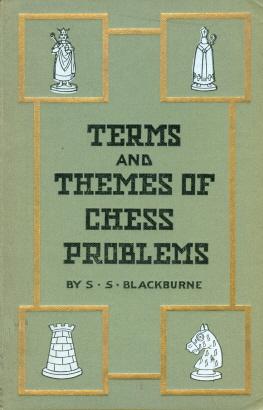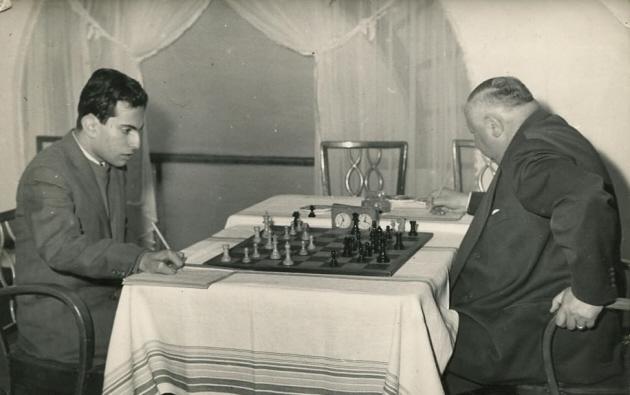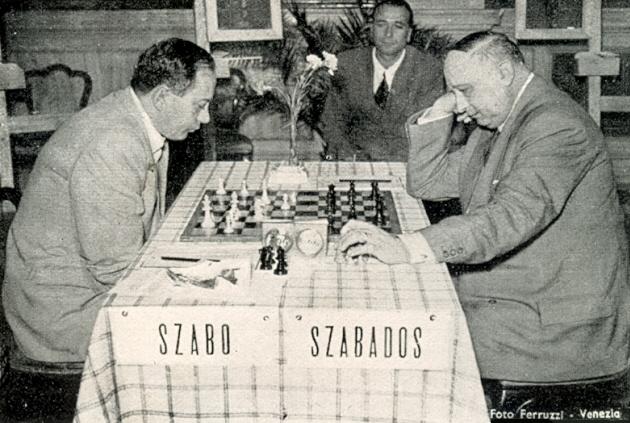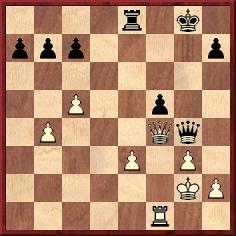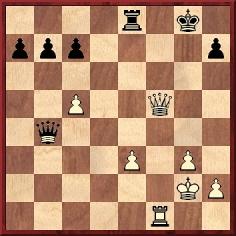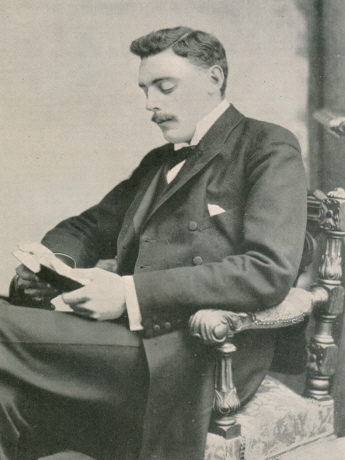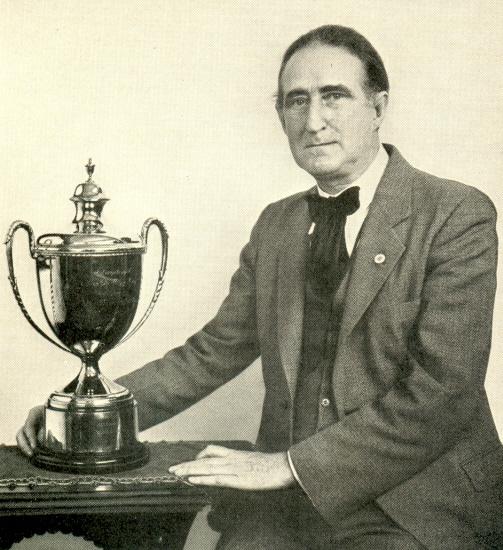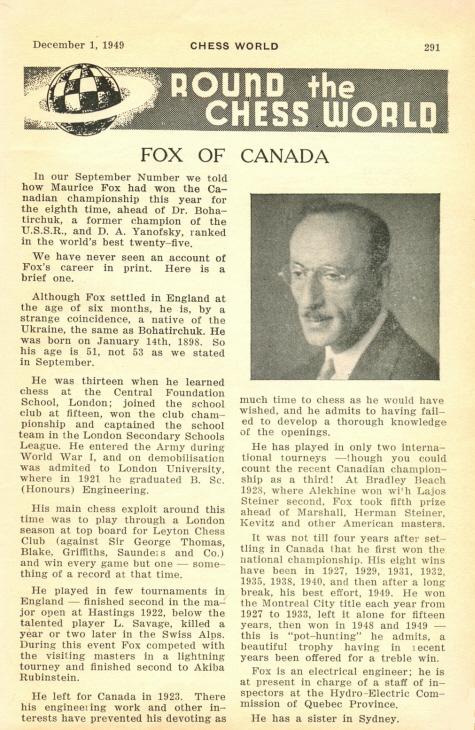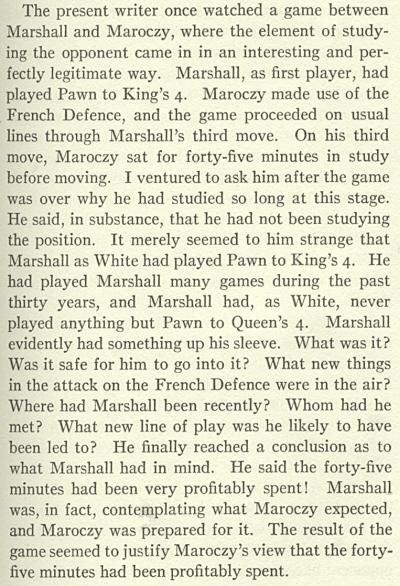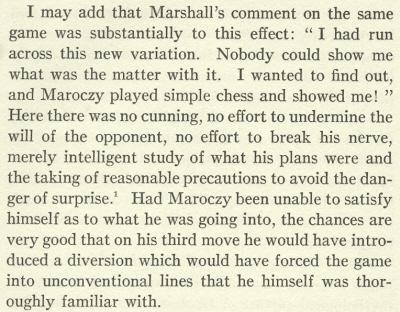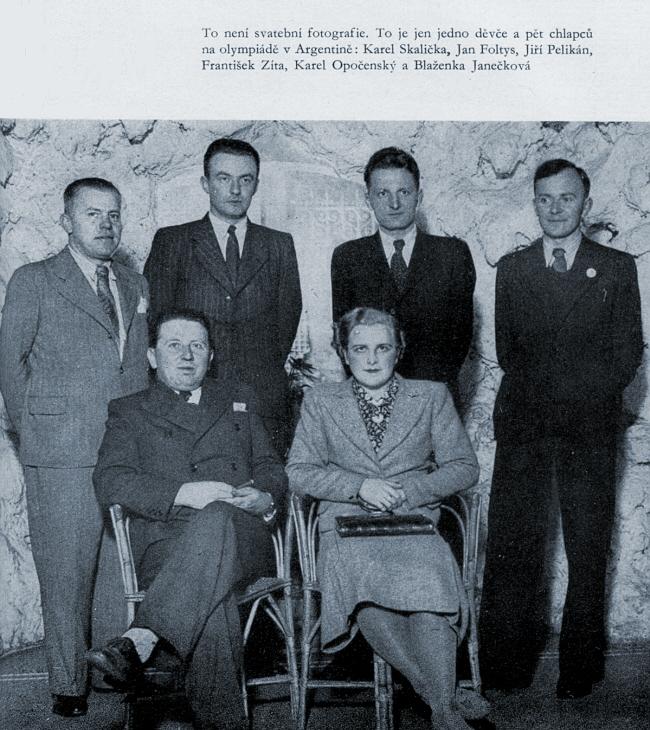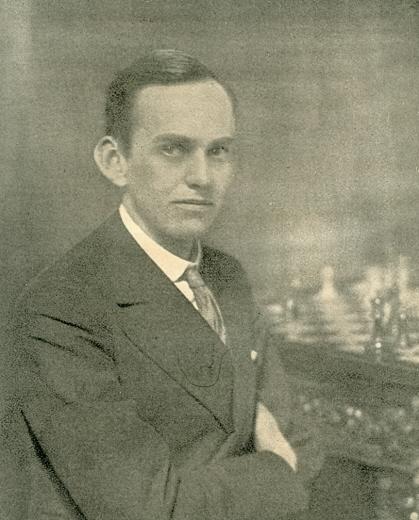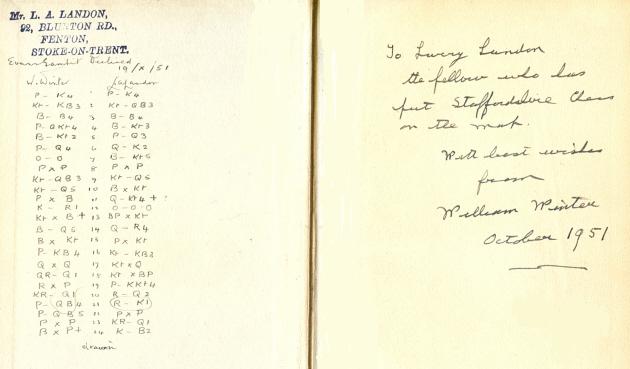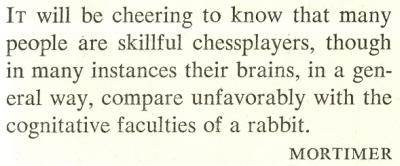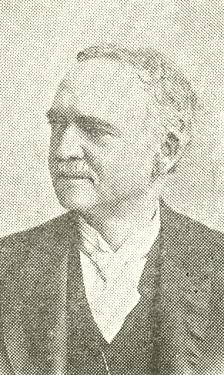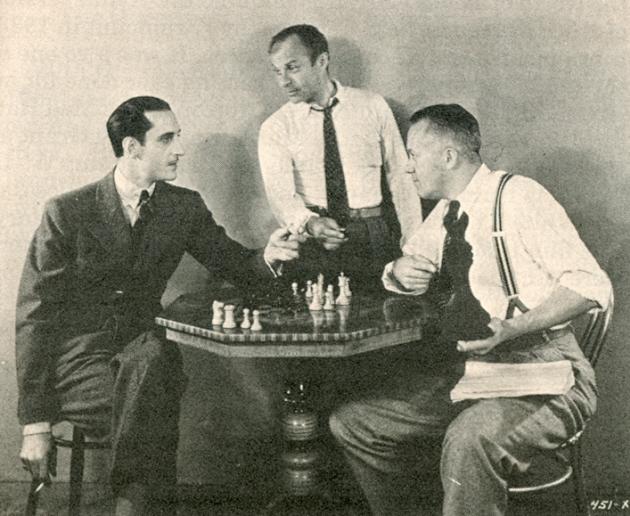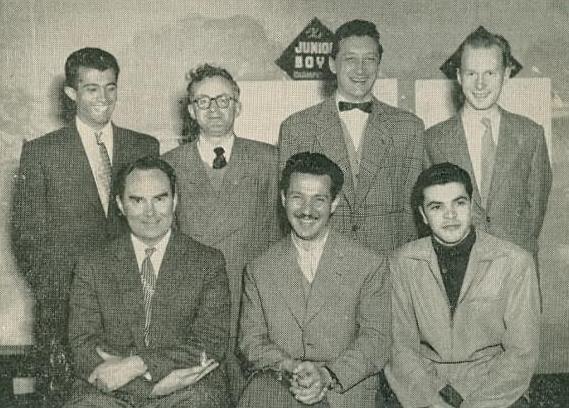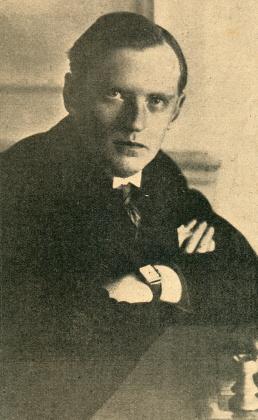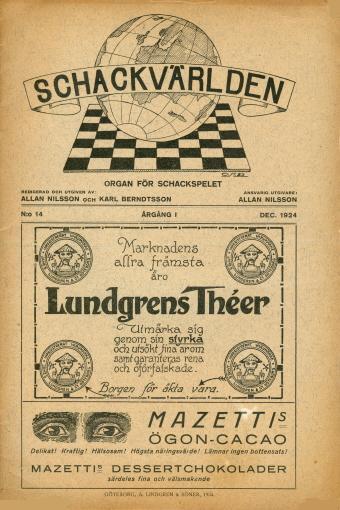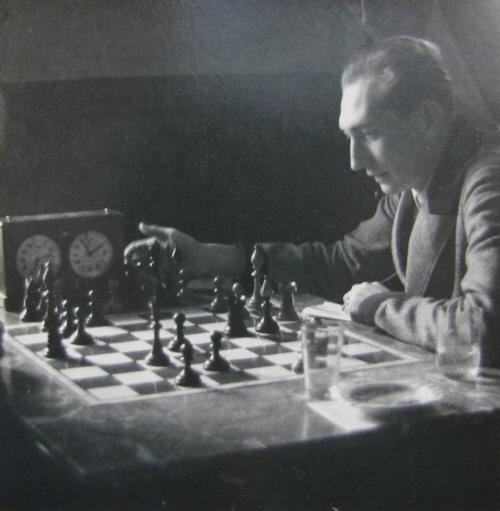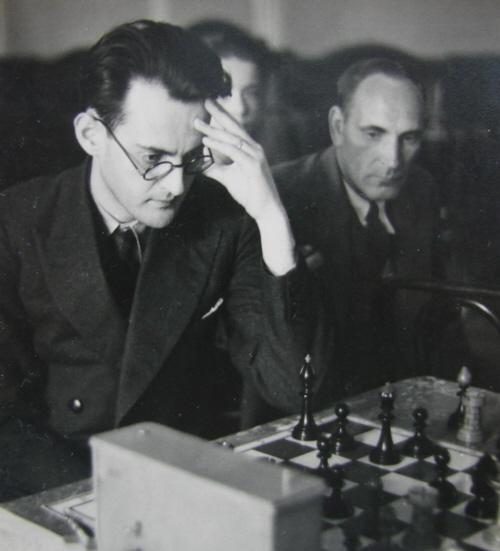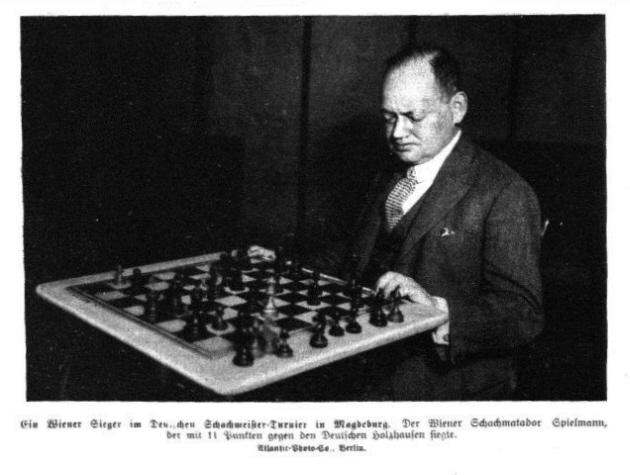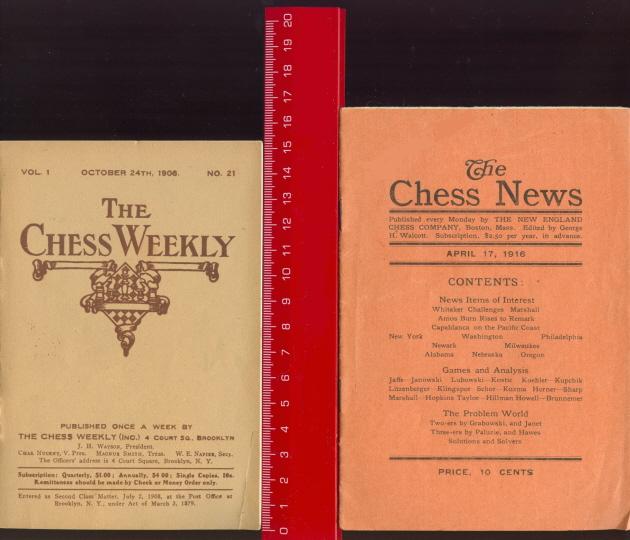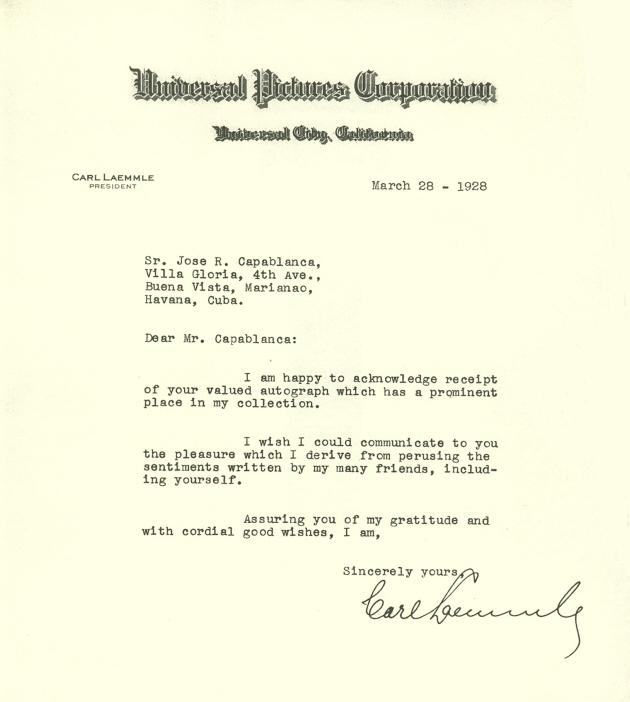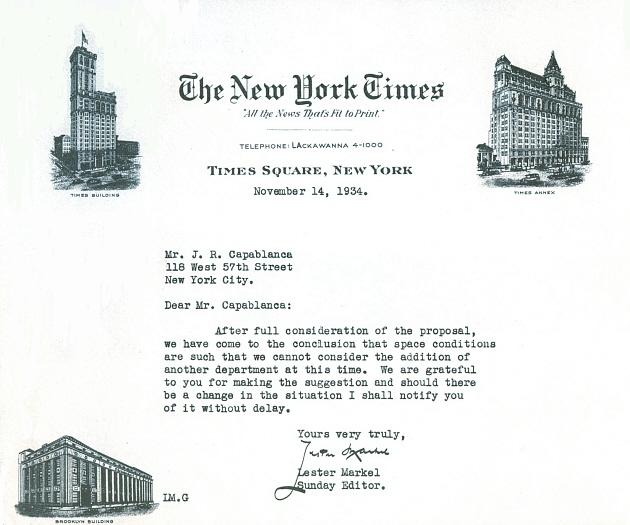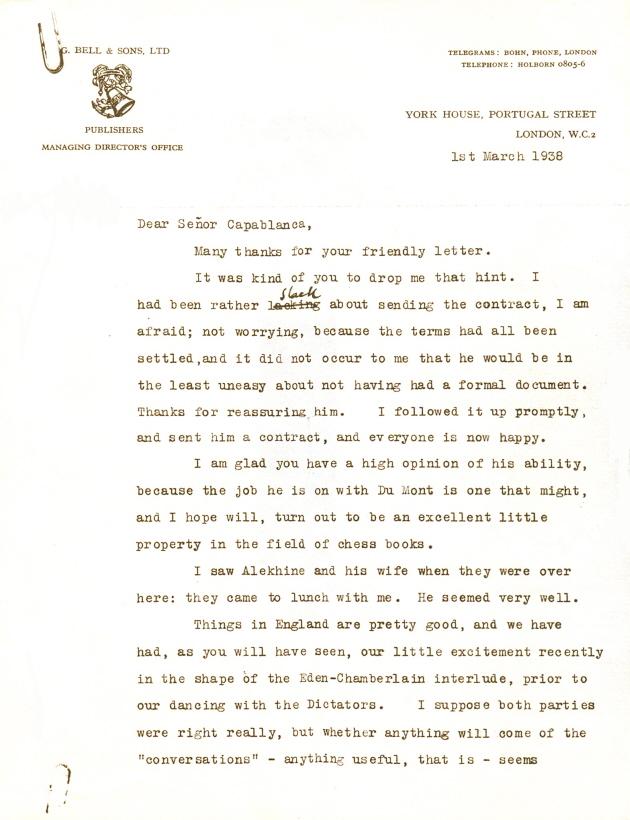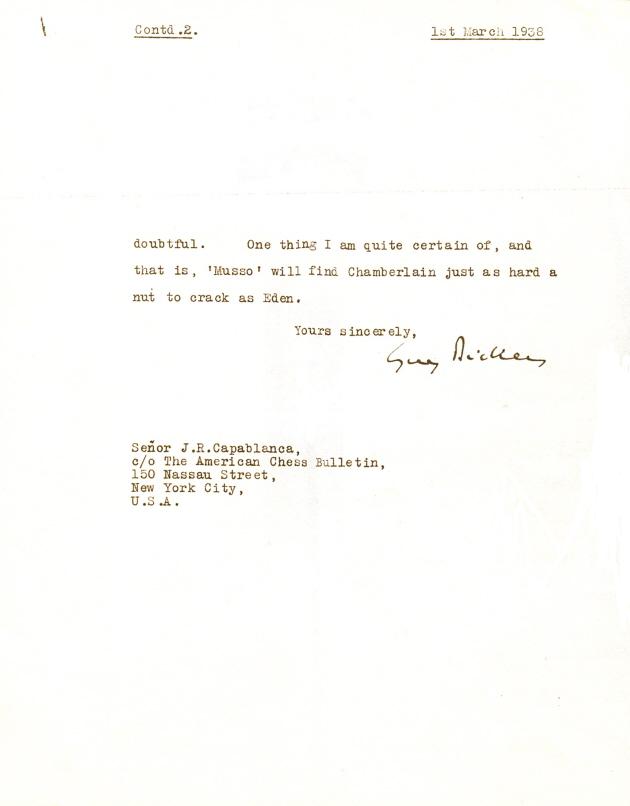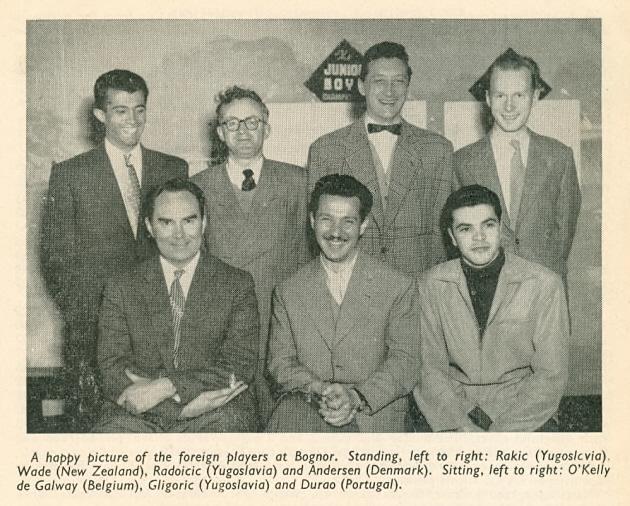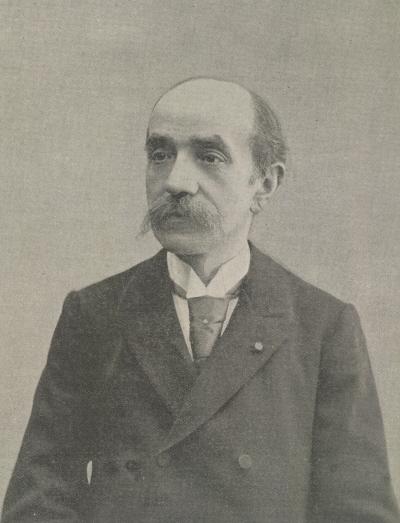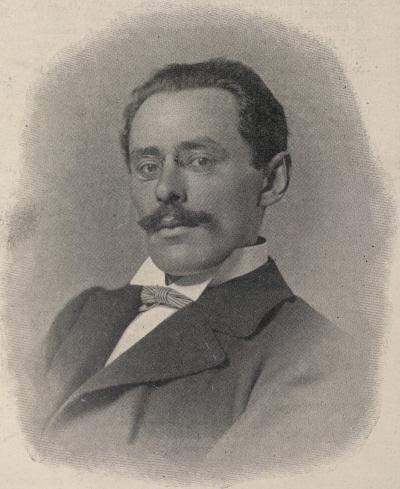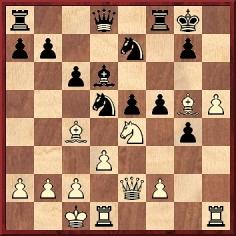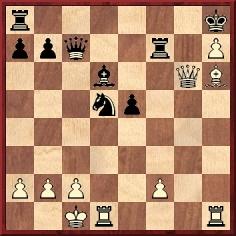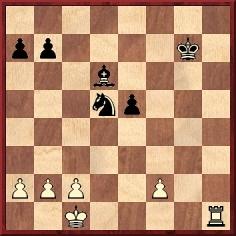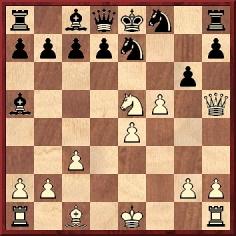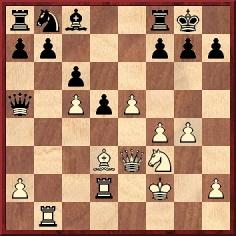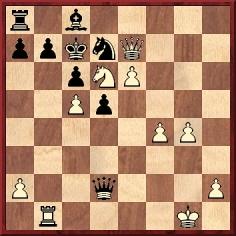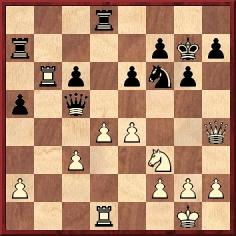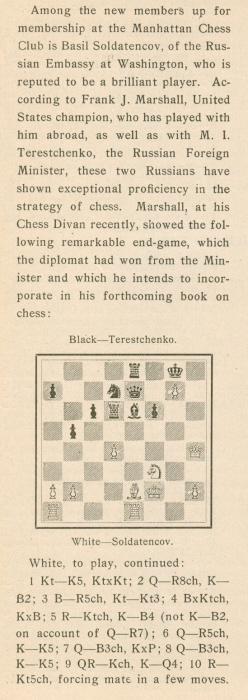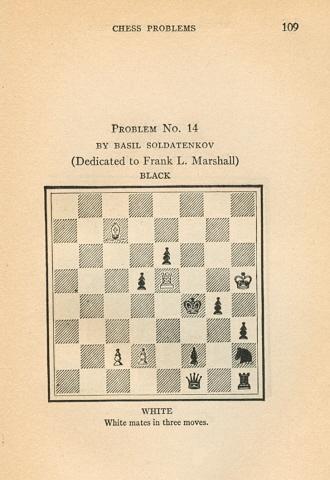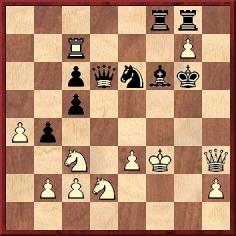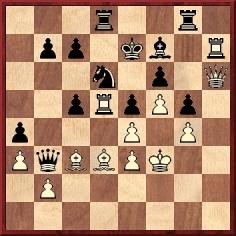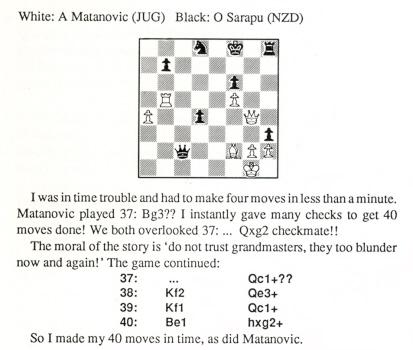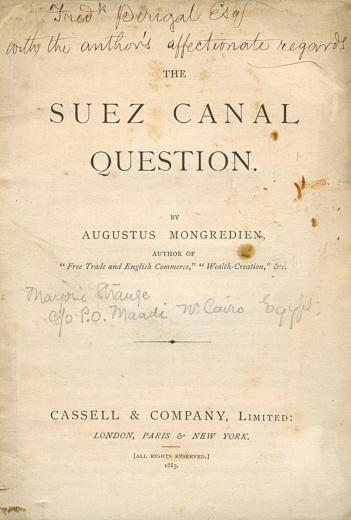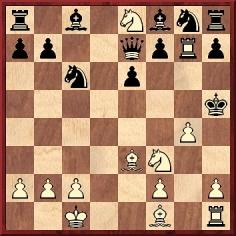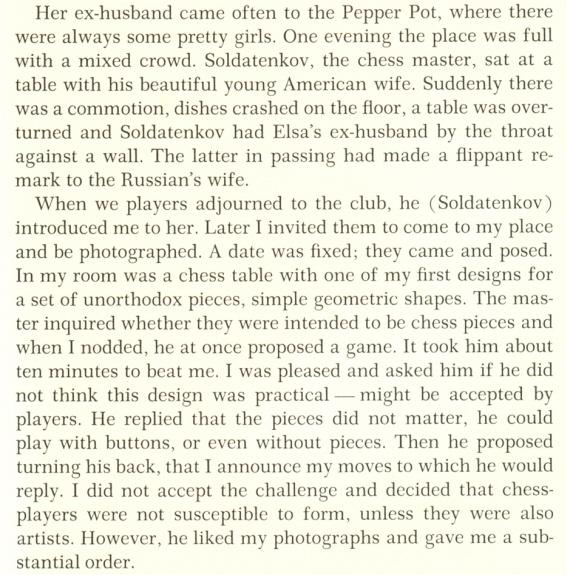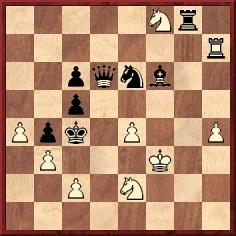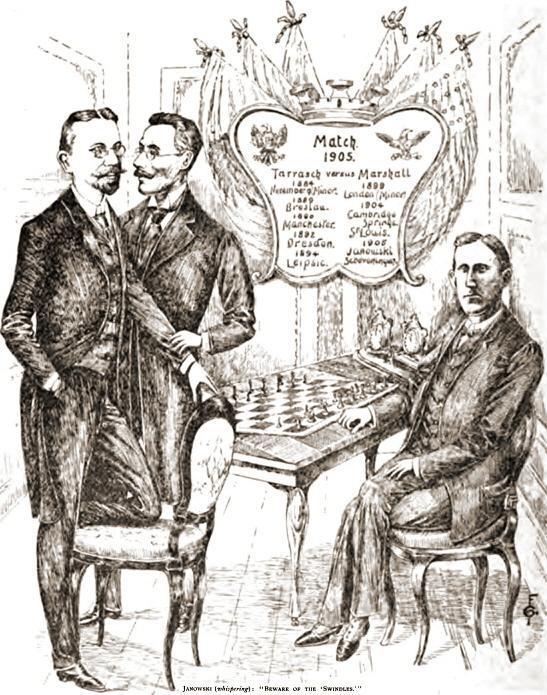Chess Notes
Edward
Winter
When contacting
us
by e-mail, correspondents are asked to include
their name and full
postal address and, when providing
information, to quote exact book and magazine
sources. The word ‘chess’ needs to appear in the
subject-line or in the message itself.
6100. Chess flower
Calle Erlandsson (Lund, Sweden) sends this photograph,
taken in his garden, of the ‘chess flower’ (Fritillaria
meleagris):
Stewart Shirley Blackburne
(1857-1934) was the author of Terms and Themes of
Chess Problems (London, 1907). His obituary on
page 409 of the October 1934 BCM referred to
other sporting interests (‘he also wrote rules for the
Lawn Tennis Association, 1883; for the New Zealand
Chess Association, 1906; and for the Canterbury
Croquet Association’), and Michael McDowell
(Westcliff-on-sea, England) draws our attention to a New
Zealand webpage which states that Blackburne
‘occasionally represented Doncaster in cricket and
football, and frequently in lawn tennis matches’.
As mentioned on pages 232-233 of Chess
Explorations and page 101 of Chess Facts and
Fables, the late Alistair Cooke drew parallels
between chess and American football. For an old
discussion of the same topic, see ‘Strategy in the New
Football’ by Walter Camp on pages 87-90 of Lasker’s
Chess Magazine, December 1907.
This photograph has been submitted by Lawrence Totaro
(Las Vegas, NV, USA). Who was Tal’s opponent and what
was the event?
From page 22 of Relax with Chess by Fred
Reinfeld (New York, 1948):
‘It was that exuberant phrase-maker and
paradox-monger Dr Tartakower who once remarked that
a pawn sacrifice requires more skill than does a
queen sacrifice. The reason? Sacrificing the queen
calls for exact calculation of a quick finish. The
pawn sacrifice, on the other hand, involves an
intuitive flair possessed as a rule only by the
great masters.’
Where did Tartakower make such a remark?
Oliver Beck (Seattle, WA, USA) writes:
‘A photograph showing Basil Rathbone, David
Burton and Nick Grinde gathered around the same
board as in C.N. 6099 appears on page 261 of the
May 1979 issue of Chess Life & Review
with the following caption:
“Basil Rathbone, before his series of film
portrayals of Sherlock Holmes, with crew members
discussing a scene in The Bishop Murder Case,
in which he played supersleuth Philo Vance.”
It comes in an article entitled “Chess in the
Cinema: Films of the Thirties”, one of a series of
articles by Frank Brady which appeared in the
magazine in 1979, and it discusses the film in
some detail.’
6106.
Bird
comment
From page 23 of My one Contribution to Chess by
F.V. Morley (New York, 1945):
‘Bird had written books. When he was in a difficulty
he used to say: “It’s all in my book – I’m sure the
answer to that is in my book.”’
Wanted: nineteenth-century corroboration of the Bird
remark (which appeared on page 29 of the London, 1947
edition of Morley’s work).
Pablo S. Domínguez (Madrid) notes that a different
account of the Simagin-Šajtar episode was given, sin
fuente, on pages 115-116 of the light-hearted
book La guía del perfecto tramposo … en Ajedrez by
Antonio Gude (Madrid, 1992).
From page 239 of Point Count Chess by I.A.
Horowitz and Geoffrey Mott-Smith (New York, 1960):
‘The ultimate triumph of the open file is to get a
rook to the seventh rank, whence it strikes at the
enemy pawn base. This “pig” (Spielmann’s epithet) is
the more odious when it also menaces the king.’
Can any details be found in Spielmann’s writings?
Tal’s opponent was Eugenio Szabados. In late October
and early November 1957 the future world champion made
a tour of Italy, and in a team match between Riga and
Venice on 31 October and 1 November he defeated
Szabados twice. See page 366 of Storia degli
scacchi in Italia by Adriano Chicco and Antonio
Rosino (Venice, 1990) and pages 164-168 of the first
‘Chess Stars’ volume of Tal’s games (1949-1962) edited
by Alexander Khalifman. The latter book gave only the
game in which Szabados was White.
Below is a photograph from opposite page 56 of the
Venice, 1949 tournament book:
6110. Anti-Semitic articles
Regarding the anti-Semitic
articles published in 1941 under Alekhine’s name,
Henk Smout (Leiden, the Netherlands) writes:
‘The June-July 1942 issue of the Tijdschrift
van den Nederlandschen Schaakbond reported on a
congress in Salzburg (held during a tournament won
by Alekhine) concerning the foundation of an
“Europaschachbund” (European Chess Federation). At
the congress Alekhine was the French representative,
and the magazine’s report (page 88) contained the
following “rectification”:
“Gedurende dit congres heeft dr Aljechin tegenover
den secretaris van den Ned. Schaakbond zijn
leedwezen betuigd over het misverstand, dat zich in
het afgeloopen jaar heeft voorgedaan als gevolg van
een onjuiste publicatie betreffende het dr
Euwe-comité, in het bijzonder ten opzichte van dr
Euwe en de heeren Van Harten en Liket.”
[“During this congress Dr Alekhine expressed
regret to the secretary of the Dutch Chess
Organization about the misunderstanding which
occurred last year in consequence of an incorrect
publication concerning the Euwe committee, and in
particular with respect to Dr Euwe and Messrs Van
Harten and Liket.”]
This was understandable only to those who knew the
Pariser Zeitung of 23 March 1941 or the Deutsche
Zeitung in den Niederlanden of 2 April 1941. It
related to the final anti-Semitic article, which
stated that the organizing committee of the 1935
match with Euwe had consisted exclusively of Jews
and that Euwe was a plaything of the Jews.
That article was not included in the Deutsche
Schachzeitung’s serialization. The German
magazine’s last instalment concluded on pages 82-84
of the June 1941 issue, and the promise “Fortsetzung
folgt” was left unfulfilled, without explanation. It
may, though, be relevant that Euwe had long been
listed by the Deutsche Schachzeitung as a
contributor. (He also became a “Mitarbeiter” of the
Deutsche Schachblätter, the official organ of
the Grossdeutscher Schachbund, as from the April
1941 issue.)
Approximately 40% of the text of the anti-Semitic
articles was not republished in the Deutsche
Schachzeitung and was therefore also absent from CHESS,
which printed an English translation of what had
appeared in the Deutsche Schachzeitung.’
Below we reproduce from our collection the relevant
part of the article as it appeared in the Deutsche
Zeitung in den Niederlanden:
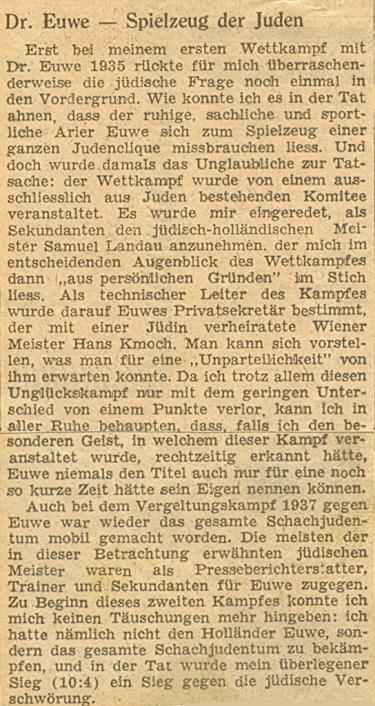
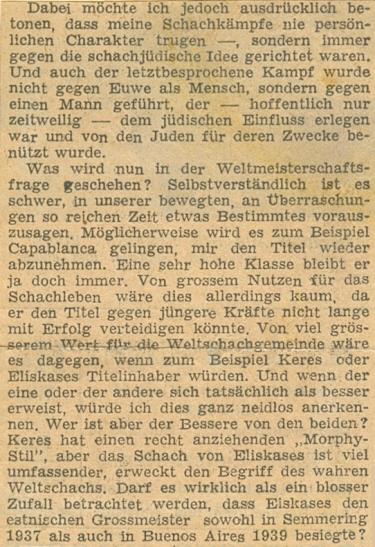
The letter below, written by J.H. Sarratt in 1810,
was reproduced in C.N. 1047 courtesy of Michael
Macdonald-Ross, its owner at that time (1985):
‘Pulteney Malcolm, Esq., &c. &c.
Sir,
The reasons which induce me to trouble you with
this communication, will, I trust, appear to you a
sufficient apology for it.
On Saturday morning, when Mr G. Sarratt arrived in
Town, I was just beginning to recover from an
illness, which, though of no considerable duration,
has been very severe. The precarious state of my
health induced me to express a desire, that Mr
Sarratt should remain with me a few days,
particularly as I was very anxious to explain fully
to him the mystery which has enveloped his early
years.
He felt exceedingly uneasy from the fear, that, if
he complied with my earnest wish, he might perhaps
subject himself to a charge of apparent remissness
in the discharge of his duty, and thus expose
himself to be deprived of that meed, which, I know,
he most highly prizes – your approbation.
However, he promised to remain with me three or
four days, on the condition that I should engage to
acquaint you with the motives of his stay – Of
course I most willingly acquiesced in a wish
dictated by propriety; and upon further
consideration, I judged it to be my duty to
communicate the following particulars to you Sir,
under whose mild and judicious sway, Mr S. will I
fervently hope, continue to improve in his “gallant
profession”, and render himself deserving of that,
after which he so ardently sighs, promotion. –
I was scarcely eighteen when I married Mr S.’s
mother in the year 1790: he was at that period three
years of age, being born June 21st 1787. At the age
of sixteen his mother had been seduced by Major John
Kelly: about a year after that unhappy event Mr S.
was born – But few months had elapsed since his
birth, when Major Kelly, regardless of his vows and
his re-iterated promises of making her his wife,
quitted the Island of Jersey, and left his destitute
victim to tears and misery. Her father for a long
time was implacable in his resentment, but relenting
at length in consequence of the intreaties of an old
and excellent female relative, he consented to be
reconciled to his daughter, though he withheld all
the tokens of affection from the hapless pledge of
her ill-fated affection.
Some months after my marriage, I suggested to my
wife the propriety of her son’s calling me father,
and being taught to consider me as his parent: of
course she assented to it, and that is the origin of
his being called Sarratt, although his name
is Kelly.
George Strange Nares, Esq. Captain, Light Company
70th. Foot, was his Godfather. He is since dead, and
neither Major Kelly nor he ever evinced the least
solicitude for the welfare of my adopted son.
Some weeks after Mrs Sarratt’s death, which
happened six years ago I wrote to George and in a
few words informed him, that, he was not my
son; at the same time I told him, that, if he wished
it, he
was perfectly at liberty still to sign his name “G.
Sarratt”, and I repeated to him, that, as long as he
continued to behave properly, he might consider me
as his unalterable and dearest friend. His affection
for me impelled him to declare, that, he should
never use any other name, that, he had never known
his father, and, that, he should ever consider me
as his parent.
It may perhaps not be superfluous to add, that, he
was born in the Island of Jersey, and, that, his
mother was daughter of an eminent Surgeon.
With respect to his Extract of Baptism
which I understand will be of utility to him, I beg
to observe, that, from the foregoing statement, it
may not be easy to obtain it: However, if it be
requisite that he should have it, I should endeavour
to procure it.
I have again to apologise for this intrusion, and,
with the highest respect,
I have the honour to remain,
Sir,
Your most obedient servant,
J.H. Sarratt.
Emigrant Office,
Bloomsbury.
12th. November 1810’
The letter from Sarratt to Malcolm was enclosed in
another letter from Malcolm to Mrs Malcolm:
(Postmarked 21 November 1810)
‘The enclosed (has) the history of your protégé
Sarratt alias Kelly – is Mrs Robinson sister to his
mother – I will be of advantage to him hereafter –
that he is a natural born subject of His Majesty –
As I know you would enjoy beating me at Chess – I
would commend you to (serve assistance to) old
Sarratt – who is a professor of Chess – writes Books
and gives lectures on it – we have one of them on
board.
PM
You must pay postage.’
(Addressed to:) Mrs Malcolm, East Lodge, Enfield,
Middlesex.
C.N. 1047 added that an entry on P. Malcolm
(1768-1838) is to be found in the Dictionary of
National Biography and that, in his letter
above, parentheses indicate parts which are not clear.
6112. Fine v Alexander
Björn Frithiof (Almhult, Sweden) asks about the game R.
Fine v C.H.O’D. Alexander, Margate, 1937, which appears
as follows in his database (ChessBase) and on pages
154-155 of Reuben Fine by A. Woodger (Jefferson,
2004): 1 d4 Nf6 2 c4 e6 3 Nc3 Bb4 4 Qc2 Nc6 5 Nf3 d6 6
a3 Bxc3+ 7 Qxc3 O-O 8 b4 e5 9 dxe5 Ne4 10 Qe3 f5 11 Bb2
Nxe5 12 Nxe5 dxe5 13 g3 Be6 14 f3 Nd6 15 Qxe5 Qe7 16 e3
Qf7 17 c5 Nc4 18 Bxc4 Bxc4 19 Kf2 Bb3 20 Bd4 Rae8 21 Qf4
Bd5 22 Be5 Bxf3 23 Bxg7 Bxh1 24 Bxf8 Rxf8 25 Rxh1 Qa2+
26 Kf1 Qxa3 27 Kg2 Qb2+ 28 Kh3 Qe2 29 Rf1 Qg4+ 30 Kg2
Re8
31 Qxf5 Qxb4
32 Rf4 Qd2+ 33 Kh3 Qxe3 34 Qd7 Qe7 Drawn.
Our correspondent comments:
‘What puzzles me is the conclusion of the game,
after 31...Qxb4. White is said to have played 32 Rf4
(instead 32 Qf7+, which wins at once), and after the
further moves 32...Qd2+ 33 Kh3 Qxe3, White had an
immediate win with 34 Rg4+.’
We believe that White’s 31st move was mistranscribed as
Qxf5 instead of Qxc7, i.e. QxKBP rather than QxQBP. The
move was given as 31 QxQBP on page 304 of the June 1937
BCM and on pages 51-52 of The best games of
C.H.O’D. Alexander by Harry Golombek and Bill
Hartston (Oxford, 1976).
6113. Gluing and nailing
Page 156 of Kings, Commoners and Knaves
commented:
‘Numerous books assert that Carl Carls always played
1 c4, except on the occasion when his c-pawn was glued
to the board. In fact, games in which Carls opened as
White with another first move may even be found in the
monograph Carl Carls und die “Bremer Partie”.’
A less common tale, on which we have no further
information, appeared on page 4 of Relax with Chess
by Fred Reinfeld (New York, 1948):
‘The story goes that a practical joker, taking
advantage of Akiba Rubinstein’s predilection for 1
P-Q4, once nailed down the grandmaster’s queen’s
pawn.’
This is Frederick Gustavus Hamilton-Russell
(1867-1941), in a photograph which appeared in the
June 1926 BCM. A portrait of Frank Marshall
with the Hamilton-Russell Cup was the frontispiece of
Marshall’s Comparative Chess (Philadelphia,
1932):
John Donaldson (Berkeley, CA, USA) writes:
‘Jeremy Gaige’s Chess Personalia states
that the Canadian master Maurice Fox was born on
14 January 1898 in the Ukraine, as per the account
in Chess World, December 1949, page 291.
That magazine also says that Fox settled in
England at the age of six months. Did his parents
emigrate to England or were they British nationals
returning after residing in the Ukraine? This
leads to the question of whether or not he was
born “Maurice Fox”. Also, was his birth-date 14
January 1898 in the Gregorian or the Julian
calendar?’
Below is the biographical item in Chess World referred
to by Mr Donaldson:
From page v of Chess Brilliants by I.O.
Howard Taylor (London, 1869):
‘Position is everything. To give up a pawn is
sometimes a bolder venture than to abandon a queen.’
6117. Ill (C.N.s 5890 & 6058)
Jerry Spinrad (Nashville, TN, USA) quotes from page 7
of part two of the New
York Daily Tribune, 3 January 1897 (a letter
dated 17 December 1896 just received from Steinitz in
Moscow):
‘Why am I so badly beaten? In the first place,
because Lasker is the greatest player I ever met,
perhaps the greatest that ever lived; to say so
positively would be like making excuses for myself and
disparaging other rivals at a time when I myself am
incapable to compete in the first rank. “A chess
master has no more right to be ill than a general on
the battle-field”, or words to that effect, I once
wrote in the International Chess Magazine, and
I adhere to that.’
We cannot explain why this wording is different from
what appears on page 337 of William Steinitz, Chess
Champion by Kurt Landsberger, where Steinitz’s
letter was quoted as stating, for example, ‘A chess
master has the same right to be sick as a general on the
battlefield’. It may be recalled from C.N. 6058 that Mr
Landsberger said that he was citing Steinitz’s letter as
published in the New York Sun, also of 3 January
1897.
Below is an extract from pages xix-xx of the Preface
by Benjamin M. Anderson Jr to Capablanca’s A
Primer of Chess (New York, 1935):
The passage was discussed in C.N.s 706 and 1177 (see
pages 117-118 and 263 of Chess Explorations),
and for the game in question we can still offer only
one candidate: Marshall v Maróczy, Lake Hopatcong,
1926. As mentioned in C.N. 5991, Anderson was in Lake
Hopatcong at the time.
6119. Buenos Aires, 1939
This photograph of the team from Bohemia and Moravia at
the 1939 Olympiad is reproduced from Nad
šachovnicemi celého světa by K. Opočenský and V.
Houška (Prague, 1960):
Our earlier items (see page 268 of Kings,
Commoners and Knaves, page 289 of A Chess
Omnibus and C.N. 4823) recorded such mishaps as
David Spanier’s description of Nimzowitsch as ‘one of
the great masters of nineteenth-century chess’. Now we
add another specimen:
‘Caissa is the Muse of Chess and was the creation
of Sir William Jones, a famous seventeenth-century
orientalist.’
Source: page 189 of The Chess Scene by D.
Levy and S. Reuben (London, 1974).
6121. The Pride and Horror of British
Chess
William Winter
The article below by G.H. Diggle, the ‘Badmaster’,
comes from page 74 of our publication Chess
Characters (Geneva, 1984). It first appeared in Newsflash,
October 1981.
‘William Winter (1898-1955), twice British Champion,
a fine chess teacher, and a writer “who could put into
one sentence as much as others could into a
paragraph”, might have been called in his heyday “The
Pride and Horror of British Chess”. Sometimes (notably
Yarmouth, 1935 and Scarborough, 1928 where he was
accompanied by a lady friend who kept an eye on him
like a Probation Officer) he would appear in a college
blazer and well-pressed flannels looking like an
ascetic curate on holiday – on other occasions he
would have been blackballed on sartorial grounds had
he attempted to join a village club consisting
exclusively of scarecrows. At London, 1945, though
reporting only and not competing, he represented the
quality press in denims and a tattered old sweater
full of holes. It is curious that such a highly
educated and cultured man, a courteous and
conscientious chess professional in every other
respect, never seemed to realize that even
chessplayers (the cream of human abnormality) set some
limit to hygienic eccentricity. It certainly lost him
professional business. The BM was once on the
Committee of a local club and the question of whom to
invite to give a simul cropped up. The BM, always a
“buy British” patriot, suggested Winter and extolled
his chess genius, but was routed by a masterful lady
member who said “that was all very well, but she
refused to be checkmated by the hand of genius if it
was garnished with dirty nails”. But strangely enough,
Winter himself was physically fastidious in some ways.
At Scarborough, as he once remarked afterwards, he
actually agreed to a premature draw with the tailender
Dr Schubert solely because he could not put up with
the Doctor’s chewing gum.
His fairness and sportsmanship over the board were
generally agreed to be of the highest order. The BM
once heard him relate the following (he was a vigorous
and animated raconteur with a staccato voice which
tended to rise to a crescendo as he “neared the
goal”): “I was playing in a County Match and after a
hard struggle was about to play the winning move when
some old duffer (he always referred to chess
rabbits as Duffers with a great accent on the “D”) –
“some old duffer with a whisper like a foghorn
hissed out N-B7 and unfortunately it was the right
move. As I could find no other way to win, of
course the game had to end in a draw.”
Even when at his least presentable, Winter always had
a vivid personality. Had he cultivated a presence as
well, and had his beard trimmed, he might have ranked
with Tarrasch as a great chess pedagogue. But he would
have got on better with Labourdonnais, like whom
Winter retained his chess faculties to the last. It
was even said that he solved a problem on the very day
of his death.’
The remark about his writing and annotations (‘he was
lucid, putting into a sentence as much as many others
put into a paragraph’) appeared in his obituary by
‘J.G.’ (James Gilchrist) on pages 28-29 of the January
1956 BCM.
This inscription and game come from one of our copies
of William Winter’s Chess for Match Players
(London, 1951):
6122. Rabbit quote
Page xii of The
Treasury of Chess Lore by F. Reinfeld (New York,
1951)
Page 15 of Chess
Quotations from the Masters by H. Hunvald (Mount
Vernon, 1972)
Above are just two examples of how ‘chess literature’
presents quotes. Not only is the source limited to a
single word, ‘Mortimer’, but the texts differ. For
instance, there is a choice between ‘cogitative’ and
‘cognitative’, and in this famous quote some websites
offer a third option: ‘cognitive’.
We have therefore gone back to the original text, in an
article by James Mortimer entitled ‘How to Win at Chess’
on page 9 of the Daily Mail, 6 October 1906:
‘To those who have taken up chess as an intellectual
and fascinating pastime, and who are often beaten at
odds by players of inferior grammar, it will be
cheering to know that many persons are skilful chess
players, though in some instances their brains, in a
general way, compare unfavourably with the cogitative
faculties of a rabbit. They are simply familiar with
the openings – the well-beaten paths discovered or
devised by the masters of the game.’
The above photograph of Mortimer was published on page
115 of The Rice Gambit by H. Keidanz (New York,
1905). For portraits of higher quality, see C.N.s 4845
and 4879.
Following publication of the agreement signed by
Lasker and Marshall on 26 October 1906 for a world
championship match (see pages 147-148 of Lasker’s
Chess Magazine, August-September 1906) James
Mortimer quoted a few unhappy passages on page 8 of
the Daily Mail, 5 December 1906 and commented:
‘All this is wonderfully weird. It may be very good
Liskeranto or very elegant Marshallpuk, but it is
certainly not very good English.’
6124.
Amy
Lowell
Bradley J. Willis (Sherwood Park, Alberta, Canada)
quotes a composition from page 136 of Amy Lowell:
Selected Poems edited by Honor Moore (New
York, 2004):
Still Life
Moonlight Striking upon a Chess-Board
I am so aching to write
That I could make a song out of a chess-board
And rhyme the intrigues of knights and bishops
And the hollow fate of a checkmated king.
I might have been a queen, but I lack the proper
century;
I might have been a poet, but where is the adventure to
Explode me into flame.
Cousin Moon, our kinship is curiously demonstrated,
For I, too, am a bright, cold corpse
Perpetually circling above a living world.
Our correspondent notes that in 1926, the year after
her death, Amy Lowell was awarded the Pulitzer Prize for
Poetry.
She was a cousin of Robert Lowell, two of whose works
were given on pages 67-68 of The Poetry of Chess
edited by Andrew Waterman (London, 1981).
From the chess column of Robert John Buckley in
the Birmingham Weekly Mercury of 15 April 1905,
page 25:
‘A curious and apparently contradictory feature in
James Mason’s character was his interminable patience.
Racially, Mason was of the most impatient, the most
impulsive, the most hot-headed temperament in Western
Europe. Mason was a Kelt of the Kelts, a really Irish
Irishman, and not in the smallest fragment of his
being, one of the Scots-Irish or the Anglo-Irish who
dominate Ulster.
And here I may tell the world something which has not
before been hinted, either in print or, so far as I
know, in any other way.
James Mason’s true name was neither James nor Mason.
His real name was confided to me years ago, as it
were, sub sigilla confessionis. Later he
wrote:
“My father adopted the name of Mason on landing in
New Orleans when I was 11, his object being
avoidance of the prejudice which obtained against
the Irish. Don’t split on me till I’m dead, and even
then I would rather you didn’t give the name, it’s
so infernally Milesian, and they’d say that all the
faults of the race went with it, particularly love
of drink and laziness. I have them both myself!”
The real James Mason was unknown and incomprehensible
to the huge majority of the people with whom he
associated, and their estimate of him, their measuring
his bushel by means of their pint-pots, is ludicrous
indeed. It may be that in the time to come this column
may present a few extracts from Mason’s letters, of
which about 400, some of them very long, regular
essays, addressed to the writer, are available.
Mason was a great letter-writer, and when addressing
people with whom he was in sympathy, was apt to let
himself go.
And thus I have strayed from the subject of Frank
Marshall to one of the “sceptred heroes who still rule
our spirits from their urns”. No matter. The Masonic
secret should be interesting. Perhaps Mason had other
confidants. Yet he was never one of those who wear
their hearts on their sleeves for daws to peck at.
One thing I wish to place on record. In money
matters; in straightness; in all things where honour
was a factor, I ever found James Mason the very soul
of integrity; and in this respect as well as
intellectually, immeasurably superior to some of the
men who smiled upon him patronizingly, and held him in
contempt because of his poverty and the well-known
weakness which all his friends deplored.’
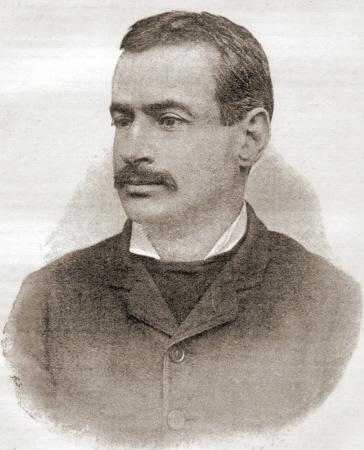 James Mason
6127. Alleged suicide attempt by
Alekhine (C.N.s 790 & 3842)
Alexander Alekhine
Jeremy Silman (Los Angeles, CA, USA) asks whether any
further details are available regarding Edmond Lancel’s
claim on pages 1152-1153 of the April 1946 issue of L’Echiquier
Belge that in 1922 Alekhine tried to stab himself
to death in the lobby of the Hotel Corneliusbad in
Aachen.
Afterword:
As reported in an endnote on page 263 of Chess
Explorations, in C.N. 862 C.D. Robinson (Toronto,
Canada) commented:
‘Alekhine is alleged to have stabbed himself about
3 a.m. after celebrating his birthday. The actual
date would be either 20 October or 1 November,
according to whether he kept his birthday on the
Russian date of 19 October or the Western date of 31
October. This allows a maximum of 24 days in which
to recover from a serious wound and to travel from
Aachen to Vienna for a tournament beginning on 13
November ... Lancel is wrong when he claims that
Vienna, 1922 was Alekhine’s worst result between
Scheveningen, 1913 and Nottingham, 1936. The earlier
limit should be Vilna, 1912 (the All-Russian
Tournament).’
C.N. 1854 offered an excerpt from the reminiscences of
Francisco José Pérez in the March 1989 Revista
Internacional de Ajedrez (page 14). Regarding
Alekhine he said:
‘While playing in a tournament in Sabadell in 1945,
Alekhine said that he did not have the courage to
commit suicide; his wife had written to him saying
that she did not want to hear from him any more.’
Calle Erlandsson (Lund, Sweden) notes that although
the run of the Swedish magazine Schackvärlden
from 1923 to 1945 extended to 22 volumes (the first of
which featured November 1923-December 1924), only the
last two years were indexed, in the respective
December issues. However, page 138 of the October 1946
Sjakkliv, a Norwegian journal, reported that
the problemist Alf O. Evang had drawn up an index for
Schackvärlden (158 densely typewritten pages
in four parts, covering 1923-28, 1929-33, 1934-38 and
1939-43) and was prepared to duplicate his
manuscript if enough orders were placed. Our
correspondent asks whether any copies of the index can
be found.
On the basis of Janowsky’s weekly chess column in Le
Monde Illustré (11 February to 18 March 1905),
as well as La Stratégie of 20 February and 17
March 1905, we list the total times taken by Marshall
and Janowsky in their 17-game match in Paris.
Marshall, who won +8 –5 =4, had White in the
odd-numbered games:
1: 4.14 – 4.11;
2: 2.30 – 2.30;
3: 2.48 – 2.13;
4: 3.48 – 4.12;
5: 3.00 – 2.48;
6: 3.19 – 3.00;
7: 2.00 – 2.12;
8: 2.05 – 1.57;
9: 4.24 – 4.21;
10: 4.14 – 4.31;
11: 3.43 – 3.46;
12: 3.10 – 2.40;
13: 4.12 – 4.40;
14: 3.20 – 2.18;
15: 2.52 – 4.57 (Le Monde Illustré) or
4.37 (La Stratégie);
16: 1.49 – 3.00;
17: 3.03 – 4.35 (times omitted by Le
Monde Illustré).
What is the soul of chess? Among the
possibilities are pawns (Philidor), combination
(Maróczy), the centre (Alekhine) and tempo (Tarrasch).
The corresponding citations can be found in the Factfinder, and we
now add the following:
- ‘... if either player had the privilege of making
two moves in succession, it is evident that he would
have no difficulty in winning the game. To gain this
one move, – with all due deference to the shade of
Philidor, – and not the play of the pawns, is the soul
of chess.’
Source: The Major Tactics of Chess by
Franklin K. Young (Boston, 1909), page 269.
- ‘Beautiful combination play is the soul of chess.’
Source: The Joys of Chess by Fred Reinfeld
(New York, 1961), page 117.
- ‘... error is the soul of chess.’
Source: Chess Players’ Thinking by Pertti
Saariluoma (London, 1995), page 153.
6131. Photographs of Eliskases, Pirc
and Spielmann
Jan Kalendovský (Brno, Czech Republic) has submitted
from his collection two photographs taken at Poděbrady,
1936:
Erich Eliskases
Vasja Pirc (and, on his
left, Bedřich Thelen)
Our correspondent has also provided a photograph of
Rudolf Spielmann at Magdeburg, 1927, from page 4 of Wiener
Bilder, 7 August 1927:
Addition on 8
August 2025:
It appears that the Spielmann photograph was taken in
Berlin in November 1926. See C.N. 12187.
6132. Small magazines
Page 398 of the August 1936 BCM announced
receipt of the first issue of Ajedrez Chileno,
‘which has the distinction of being in format the
smallest chess magazine, we believe’. Page 39 of the
January-February 1937 L’Echiquier stated that
the size of the Chilean magazine (which we have not
seen) was 13cm x 18cm, but that is substantially larger
than two earlier publications that come to mind:
C.N. 4244 showed our smallest chess book (approximately
6cm x 4cm).
Our collection includes copies of many letters
addressed to Capablanca, and three are reproduced
below:
6134.
Pollock
Olimpiu G. Urcan (Singapore) notes that in the Preface
to her book Pollock Memories (Dublin, 1899) F.F.
Rowland mentioned among her sources ‘interesting MMS.
books, belonging to Mr Pollock, which contained about
3,000 games entered by himself, and played by Masters
and distinguished amateurs, with critical remarks by Mr
Pollock’. Our correspondent asks whether this material
is known to have survived.
The photograph in C.N. 6125 came from page 195 of CHESS,
17 May 1957:
Paul Dorion (Montreal, Canada) mentions that the Pirc
photograph from Poděbrady, 1936 shows the position
after Black’s 36th move in the game against Karel
Skalička (see page 45 of the tournament book).
6137. Rosenthal and Janowsky
The following photographs appeared in Le Monde
Illustré on, respectively, 20 September 1902 (page
288) and 27 September 1902 (page 312):
Samuel Rosenthal
Dawid Janowsky
6138. Soldatenkov
Three games involving the little-known player
Soldatenkov were given in 1000 Best Short Games of
Chess by I. Chernev (New York, 1955): victories
against an anonymous player and F.J. Marshall (in 17 and
21 moves respectively and both published on page 433 of
the November 1928 BCM) and The Consultation Game
That Never Was. Another brilliancy is on pages
43-44 of Kings, Commoners and Knaves:
Vassily Soldatenkov – N.N.
Occasion?
Ruy López
1 e4 e5 2 Nf3 Nc6 3 Bb5 Nf6 4 d3 d6 5 Be3 Bd7 6 Nbd2 d5
7 exd5 Nxd5 8 Qe2 Bd6 9 Ne4 Bg4 10 O-O-O O-O 11 h3 Bh5
12 g4 Bg6 13 h4 h5 14 Nfg5 hxg4 15 h5 Bxe4 16 Nxe4 f5 17
Bc4 Ne7 18 Bg5 c6
19 h6 g6 20 h7+ Kh8 21 Bh6 fxe4 22 dxe4 Rf7 23 Qxg4 Nf6
24 Qg5 Ned5 25 exd5 cxd5 26 Qxg6 Qc7 27 Bxd5 Nxd5
28 Qg8+ Rxg8 29 hxg8(Q)+ Kxg8 30 Rdg1+ Rg7 31 Rxg7+
Qxg7 32 Bxg7 Kxg7
33 Rd1 and wins.
Source: The Times Literary Supplement, 24
October 1902, page 320.
Below are some further neglected games:
Vassily Soldatenkov – Fürst G.
St Petersburg, 24 April 1902
(Remove White’s queen’s knight.)
1 e4 e5 2 d4 Nc6 3 dxe5 Nxe5 4 f4 Ng6 5 Nf3 Bb4+ 6 c3
Ba5 7 Bc4 N8e7 8 f5 Nf8 9 Bxf7+ Kxf7 10 Ne5+ Ke8 11 Qh5+
g6
12 f6 Ne6 13 f7+ Kf8 14 Bh6+ Ng7 15 Qh4 Nc6 16 Bg5 Ne7
17 Rf1 d6 18 Bxe7+ Qxe7 19 Nxg6+ hxg6 20 Qxh8 mate.
Source: Deutsche Schachzeitung, July 1902,
pages 215-216.
Vassily Soldatenkov – A.J. Barasov
St Petersburg (date?)
French Defence
1 e4 e6 2 Qe2 Nf6 3 f4 Bc5 4 Nf3 O-O 5 d4 Bb6 6 e5 Nd5
7 c4 Ba5+ 8 Kf2 Ne7 9 Nc3 c6 10 g4 d6 11 Be3 dxe5 12
dxe5 Bb6 13 Rd1 Bxe3+ 14 Qxe3 Qb6 15 c5 Qxb2+ 16 Rd2 Qb4
17 Bd3 Nd5 18 Nxd5 exd5 19 Rb1 Qa5
20 Bxh7+ Kxh7 21 Ng5+ Kg8 22 Qd3 f5 23 Qh3 Qxd2+ 24
Kg1 Re8 25 Qh7+ Kf8 26 Qh8+ Ke7 27 Qxg7+ Kd8 28 Qf6+ Re7
29 Nf7+ Ke8 30 Nd6+ Kd7 31 Qxf5+ Re6 32 Qf7+ Re7 33 e6+
Kc7 34 Qxe7+ Nd7
35 Qxd7+ Bxd7 36 Rxb7+ Kd8 37 Rxd7 mate.
Source: Page 171 of Traité du jeu des échecs by
J. Taubenhaus (Paris, 1910). Brief notes by Soldatenkov
were included.
Vassily Soldatenkov – Frédéric Lazard
Café de la Régence, Paris, 9 January 1912
Queen’s Gambit Declined
1 d4 d5 2 Nf3 Nf6 3 c4 e6 4 Nc3 dxc4 5 Bg5 Be7 6 e3 Nd5
7 Bxe7 Nxc3 8 bxc3 Qxe7 9 Bxc4 O-O 10 O-O b6 11 Bd3 Nd7
12 Qc2 g6 13 Be4 Rb8 14 Qa4 a5 15 Bc6 Rd8 16 Rfd1 Bb7 17
Bxb7 Rxb7 18 Qc6 Ra7 19 Rab1 Qd6 20 Qe4 Nf6 21 Qh4 Qe7
22 e4 Kg7 23 Rb5 c6 24 Rxb6 Qc5
25 e5 Qxb6 26 exf6+ Kf8 27 Qxh7 Ke8 28 Ne5 Qc5 29 Qg8+
Qf8 30 Qxf8+ Kxf8 31 Nxc6 Resigns.
Source: La Stratégie, January 1912, pages
23-25. The game was annotated by ‘A.G.’, who concluded:
‘La partie a été un peu légèrement jouée par le
jeune champion de la Régence et ne donne pas la
mesure de sa force. Par contre, le brillant amateur
russe l’a conduite avec une précision et une logique
impeccables. Nous considérons Mr Soldatenkoff comme
un des plus forts joueurs de Paris. Personne n’a
plus de science ni de brio.’
From page 224 of the American Chess Bulletin,
November 1917 (an item headed ‘Ending between Russian
Diplomats’):
A computer check shows that White missed a number of
faster wins.
Soldatenkov’s name became associated with 1 e4 e5 2 f4
Bc5 3 Nf3 d6 4 fxe5 (the ‘Soldatenkov Attack’ or
‘Soldatenkov Variation’) after the following appeared on
page 124 of the Carlsbad, 1907 tournament book by Marco
and Schlechter:
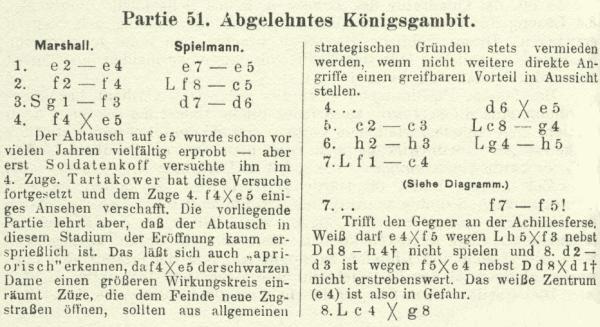
A number of Soldatenkov’s early games in Russia,
together with much other material, were given in a small
monograph on him, Tajemný Námořník by V. Čarušin
(Brno, 1998). The New York Times (15 October
1917, page 16) reported that a Marshall/Soldatenkov v
Janowsky/Jaffe consultation game had just begun (‘The
contest will probably extend over the greater part of
the week. Marshall and Soldatenkov, playing the white
pieces, elected a queen’s pawn opening, to which the
rival pair replied with knight to king’s bishop
third.’). Further information would be welcome. Page 210
of the December 1921 American Chess Bulletin
gave the score of an 18-move draw by Soldatenkov against
Perkins which was played in a Metropolitan League match
between the Marshall Chess Club and the Brooklyn Chess
Club. A loss by Soldatenkov to Zirn in the Metropolitan
Chess League was published on page 25 of the February
1922 American Chess Bulletin. More details are
sought about the game ending ‘Soldatenkov-Wolf, Berlin,
1925’ given on pages 119-120 of The Joys of Chess
by F. Reinfeld (New York, 1961). Soldatenkov’s 21-move
victory over Marshall referred to at the beginning of
the present item was published by H. Wolf on pages
300-301 of the September-October 1928 issue of Kagans
Neueste Schachnachrichten. Clarification of the
circumstances of the game, together with notes by
Soldatenkov himself, appeared on pages 197-200 of the
June 1929 issue. A lengthy article by Soldatenkov was
published on pages 221-226 of the July 1929 Kagans
Neueste Schachnachrichten. It discussed a recent
victory over A. Zimine in the light of a Bogoljubow v
Euwe game (the seventh contest in their second match,
played in Amsterdam on 2 January 1929 – see pages 53-54
of the February 1929 Wiener Schachzeitung).
Below is page 109 of the revised edition of Mitchell’s
Guide
to the Game of Chess by David A. Mitchell
(Philadelphia, 1920):
Soldatenkov also has a bearing on the origins of the Marshall Gambit
in the Ruy López. At New York, 1918 Marshall played
8...d5 twice, against Capablanca and Morrison. Regarding
the latter game it was pointed out on page 276 of the
December 1918 American Chess Bulletin (under the
heading ‘Duplication of Game after 17 Years’) and on
page 21 of the tournament book that a game Sittenfeld v
Soldatenkov, Paris, 1901 had followed Morrison v
Marshall as far as move 18 (when Soldatenkov played
...Bd6 instead of ...gxf6). Whereas Marshall’s victory
took 84 moves, Soldatenkov won in 25.
Without reference to these American sources, the
Sittenfeld v Soldatenkov game was given by Kevin
O’Connell on page 186 of the April 1980 BCM (in
K. Whyld’s ‘Quotes & Queries’ column). It was stated
that O’Connell had found the game in La Stratégie
for 1901, but we do not see it there.
On pages 314-315 of the July 1987 BCM we quoted
from, and commented on, the above-mentioned American
Chess Bulletin item. Page 612 of the November 1999
BCM (also in the ‘Quotes & Queries’ column)
referred to the difficulty in finding biographical
information about Soldatenkov (whose birth details were
given as 14 July 1879 at Tsarskoye Selo – as mentioned
on page 3 of the booklet on Soldatenkov by
Čarušin/Charushin).
The lack of information about Soldatenkov (e.g. where
and when he died) is particularly strange in view of his
prominence as a diplomat on both sides of the Atlantic.
A lengthy political article on page 12 of the New
York Times, 20 October 1918 included the
following:
‘Basil Soldatenkov, standing six feet in his socks
and as hard as nails, his deep-set gray eyes looking
you straight through from beneath the ledge of a
massive brow crowned with waving light brown hair, is
a comparatively young man to have had the experiences
and to have shouldered the responsibilities which have
been his.
He is, perhaps, five and thirty, and by natural
mental inclination a mathematician and electrical
engineer. On leaving the university, it was his
intention to make scientific research his life work,
but circumstances led him, first, to try for and win a
commission in the Russian navy, and later to enter the
Russian Diplomatic Corps.
Mr Soldatenkov served the Imperial Russian Government
in nearly every capital of Europe. There are few men
living who have as intimate a personal acquaintance
with the great diplomats of the world. He came to this
country on a special mission from the Kerensky
Government.’
It will be noted that his forename was given as
‘Basil’, i.e. the anglicized version of Vassily.
However, page 63 of the March 1918 American Chess
Bulletin referred to ‘Boris Soldatenkoff, the
Russian envoy’. Because of German transliteration, the
initial of his forename was sometimes recorded as W
(‘Wassily’). The index for the 1907 volume of Deutsches
Wochenschach (page 483) had ‘Soldatenkow, W.W. (St
Petersburg)’.
Below is an extract from the New York Times, 18
March 1920, page 11:
‘Mr and Mrs Basil Soldatenkov yesterday surprised
their relatives and friends by announcing they had
been married in Newark, NJ on Tuesday. Mrs Soldatenkov
was formerly Miss Madeleine Reese, niece of Martin
Vogel, Assistant United States Treasurer, and Mrs
Vogel, with whom she had resided since the death of
her mother six years ago.
Mr Soldatenkov, who was a special envoy of the
provisional Government of Russia, had been attentive
to Miss Reese for some time, but Mr and Mrs Vogel
withheld their consent to the marriage, owing chiefly
to the disparity of their ages, their niece being only
20 years of age and Mr Soldatenkov about 17 years her
senior ...
Mr Soldatenkov has been married before. His first
wife was the Princess Gotchakoff of Russia, from whom
he was divorced last November.
Mr Soldatenkov was Under Secretary of State in Russia
under the Milyoukof régime. He met and took charge of
Elihu Root and the American Mission when it arrived in
Russia, and returned here with the Mission. On his
arrival he was thanked personally by President Wilson
and Mr Root and was presented with a cigarette case
bearing an inscription in acknowledgment of his
services to the American Mission.’
The above two references to Soldatenkov in the New
York Times suggest that he was born in or around
1883. It was subsequently reported by the newspaper (21
December 1928, page 13, and 11 October 1933, page 27)
that the couple were divorced in Nice in October 1928.
On 10 October 1933 the marriage took place in London
between Madeleine Soldatenkov and ‘Baron Constantine
Nicolai Stackelberg, whose father, Baron Nicolai
Stackelberg, was a master of ceremonies at the court of
the late Czar Nicholas of Russia’.
The Family
Search website produces the information that
‘Vasilij Vassilievich Soldatenkov’ was born circa
1869 in ‘Tachanj, Pltv, Ukraine’ and that he married
‘Elena Konstantinovna, Princess Gorchakov’ on 20 January
1901. However, there is also an entry for ‘Basil
Soldatenkow’, born in Moscow on 14 June 1877.
The search for biographical details about Soldatenkov
continues, and for the time being we conclude with a
quiz question arising from one of his early games:
White to move. What is the fastest
win?
6139. Marini v Spassky
Jake Freeman (Salt Lake City, UT, USA) raises the
subject of L. Marini v B. Spassky, Mar del Plata, 1960,
which appears in databases as follows: 1 c4 Nc6 2 Nc3
Nf6 3 g3 e5 4 Bg2 Bc5 5 a3 a5 6 e3 O-O 7 Nge2 Re8 8 d3
d6 9 h3 Bd7 10 Bd2 Qc8 11 Qc2 Ne7 12 Ne4 Nxe4 13 dxe4
Be6 14 Nc1 a4 15 Nd3 Nc6 16 Nxc5 dxc5 17 f4 f6 18 f5 Bf7
19 g4 Rd8 20 Bf1 g5 21 h4 h6 22 Bc3 Kg7 23 Qh2 Rh8 24
Be2 Qe8 25 Kf2 Rd8 26 Qg3 Qe7 27 Rh3 Na7 28 Rah1 Nc8 29
Qh2 Rhg8 30 hxg5 hxg5 31 Rh7+ Kf8 32 Bd1 Qd7 33 Bc2 Nd6
34 Kf3 Nxc4 35 Rd1 Nd6 36 Qh6+ Ke7 37 Rd5 Qb5 38 Bd3 Qb3
39 Be2 Drawn.
Regarding the diagrammed position Mr Freeman comments:
‘Instead of 39 Be2, there is 39 Bxe5 fxe5 40 Qe6+
Kf8 41 Rxf7+ Nxf7 42 Bc4 Qxc4 43 Rxd8+ Nxd8 44 Qxc4,
winning easily. If Black plays 42...Re8, then 43
Qxf7+, followed by 44 Rd7+ and mate next move.’
To our list of ‘Mates missed’ in the
Factfinder
Frederick S. Rhine (Park Ridge, IL, USA) adds the
account on page 51 of ‘Mr Chess’ The Ortvin Sarapu
Story by Ortvin Sarapu (Wainuiomata, 1993):
Matanović eventually agreed to a draw after Black’s
54th move.
6141. Mongredien (C.N. 4895)
Below from our collection is another inscribed title
page of a non-chess book by Augustus Mongredien:
The Suez Canal
Question (London, 1883), inscribed to Frederick
Perigal
From Rod Edwards (Victoria, BC, Canada):
‘C.N. 5048 quoted G.A. MacDonnell, who said that
the remarkable Campbell v Barnes match (in which
Campbell won 7-6 after being down 1-6) took place
in 1861. However, page 100 of the Chess
Player’s Chronicle, 1859 stated that the match
occurred in 1858.’
In this game White played without his queen but made
the first two moves: 1 e4 ... 2 d4 d5 3 exd5 Qxd5 4
Nc3 Qxd4 5 Be3 Qe5 6 O-O-O Nc6 7 Nf3 Qa5 8 Rd5 Qb4 9
Nb5 e6 10 Nxc7+ Ke7 11 Bc5+ Kf6 12 Ne8+ Kg6 13 Rg5+
Kh6 14 Be3 Qe7 15 Rxg7+ Kh5 16 g4 mate.
The victor was Adolf Albin, against an unnamed
opponent, and the score was given on page 180 of 1000
Best Short Games of Chess by Irving Chernev
(New York, 1955). No place or date was specified, but
we note that the game was published on pages 366-367
of La Stratégie, 15 December 1901, having been
played a few days previously at the Cercle Philidor in
Paris.
6144. Soldatenkov (C.N. 6138)
Vitaliy Yurchenko (Uhta, Komi, Russian Federation)
reports that page 43 of the Russian edition of the
monograph by V. Charushin (Omsk, 2000) reproduced
Soldatenkov’s Полный послужной список (complete service
record), dated 13 January 1913. It gave his birth-date
as 14 July 1879 (old style).
We have found a passage about Soldatenkov on page 99 of
Self Portrait by Man Ray (Boston and Toronto,
1963). Elsa Schiaparelli has just been mentioned.
Page 243 reproduced the well-known (indoor) photograph
of Man Ray playing chess with Marcel Duchamp (Paris,
1956).
6145. Forced mate (C.N. 6138)
This position (White to move) at the end of C.N. 6138
came from page 52 of the 15 February 1898 issue of La
Stratégie, which stated that White (Soldatenkov)
gave mate in eight moves. The solution on page 119 of
the 15 April 1898 magazine was 1 Qh7+ Kxh7 2 gxf8(N)+
Kh6 3 Rh7+ Kg5 4 h4+ Kf5 5 e4+ Ke5 6 Nc4+ Kd4 7 Ne2+
Kxc4 8 b3 mate.
However, it was also pointed out by La Stratégie
that two correspondents (Guinet and Buckley) had offered
a quicker finish (4 Nde4+ Kf5 5 Nxd6+ Ke5 6 Nf7+ Kf5 7
e4 mate).
When the initial position was given on page 16 of the
Czech edition of V. Charushin’s booklet on Soldatenkov
(the source being specified as Shakhmatny Zhurnal,
1897, page 357) Black had two additional pieces: a
knight on b7 and a bishop on c4. There is then no mate
in seven, and the fastest mate is the above line ending
in 8 b3.
Jens Kristiansen (Qaqortoq, Greenland) is trying to
ascertain the highest age at which anyone has gained
the grandmaster title for over-the-board play in
regular fashion (and not, for instance, honoris
causa).
A chess bookshop which can be
recommended for its impressive stock and efficient
service is run by Kimmo
Välkesalmi in Helsinki.
6148. Chess prodigies
Christopher Lenard (Bendigo, Victoria, Australia)
writes:
‘Does any comparative study exist of the early
games of chess prodigies, i.e. the games of
youngsters who have a strong natural aptitude but
have not yet been exposed to much formal study? In
particular, I am interested in what similarities, if
any, exist among such players from over the last
century or so. For example, do very strong but
“naïve” (untutored) players tend to spot and exploit
certain types of patterns?’
The subject of chess prodigies has received
surprisingly little treatment in chess literature. For
an historical sweep, only two books come to mind – Great
Games by Chess Prodigies by Fred Reinfeld (New
York, 1967) and Los niños prodigio del ajedrez
by Pablo Morán (Barcelona, 1973) – but neither adopted a
scientific or academic approach. Can readers quote any
articles covering the specific field mentioned by our
correspondent or dealing authoritatively with the more
general topic of chess Wunderkinder? We hope to
build up a bibliography at the end of the Chess Prodigies
article.
From Olimpiu G. Urcan (Singapore) comes this sketch
on page 438 of the November [sic – it was
mistakenly headed ‘October’] 1905 BCM:
Caleb Wright (Ohauiti, Tauranga, New Zealand) asks
for solid information about reports that the Soviet
computer KAISSA helped David Bronstein in an adjourned
game in 1975.
Firstly, we quote a passage from page 128 of How
Computers Play Chess by D. Levy and M. Newborn
(New York, 1991):
‘The first occasion on which a program’s ability to
play certain endgames perfectly was useful to human
players was at a Soviet tournament in 1975. There,
in Vilnius, Grandmaster David Bronstein was able to
use a database created by the KAISSA team to help
him analyze an adjourned game, which he subsequently
won. This was the ending of queen and knight’s pawn
(g-pawn or b-pawn) against queen, the most difficult
of all queen and pawn endings.’
Such an ending, we note, occurred in Bronstein’s game
in Vilnius against Karen Grigorian. More details, from
primary sources, of the computer’s involvement will be
appreciated.
For other information on KAISSA, see chapter six of Chess
in the Eighties by D. Bronstein and G. Smolyan
(Oxford, 1982).
Chess Notes Archives
Copyright: Edward Winter. All
rights reserved.
|

